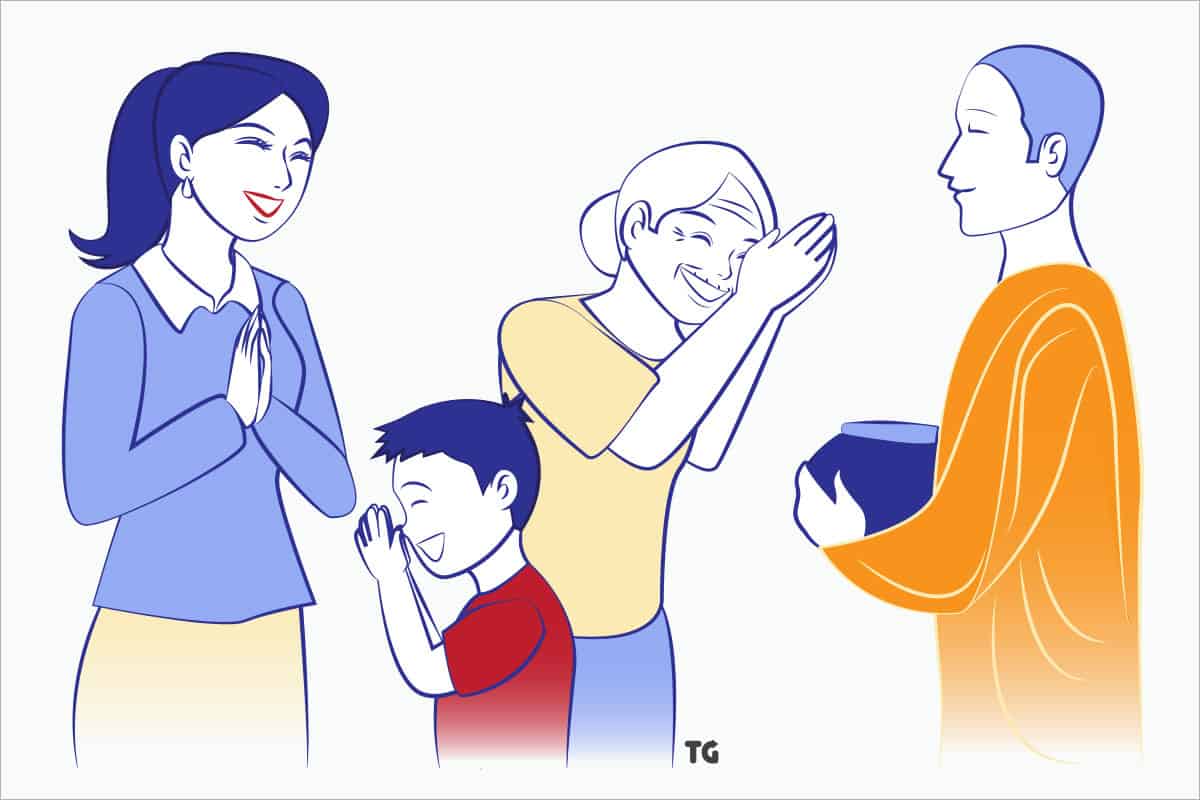Many Asian countries have their own traditional greeting. Japan has a bow, India has Namaste, and Thailand has Wai. So, you should learn to perform a warm and proper greeting like Wai when visiting Thailand.
A traditional Thai greeting is the Wai. Thai people greet each other with this warm gesture by clasping their hands on their chests, bowing, and saying, “Sawasdee.” The Thai Wai has 3 levels, which have different head-to-hand positions and purposes. Knowing when to perform at what level is crucial to showing respect.
Moreover, you can perform Wai on more occasions than a greeting. Read on to learn more about this delicate Wai culture, the symbol of respect in Thailand.
What is the traditional way of a warm greeting in Thailand?
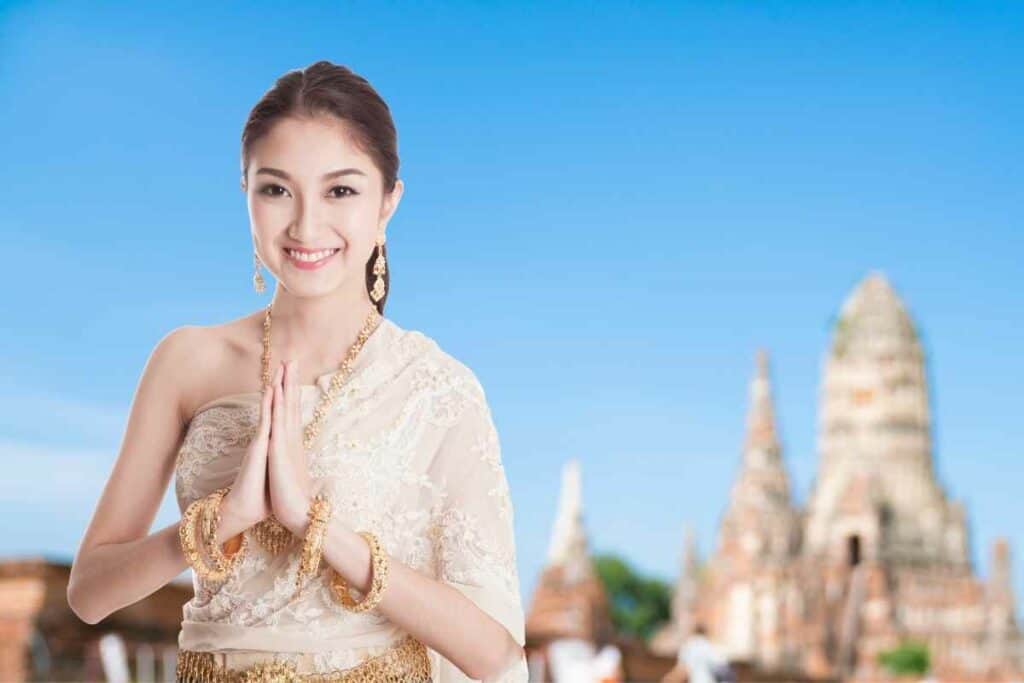
Thai people greet each other by performing a “Wai” (ไหว้). It is the nation’s signature and traditional greeting, famous for its beauty and elegance.
However, if you dig down the dirt of history, you will find that Wai actually has its origin in India. (Source)
Its appearance and processes are similar to Namaste. If you were not careful, you could even mistake them for one of the same.
Performing a Wai is simple. There are only three steps you have to follow.
- Clasp your hands together at your chest. Make sure all your fingers are straight and adjoin each other — similar to when you clap.
- Bow your head down until parts of your face touch your fingers. (Which parts touch which fingers is a matter of “levels.” You’ll read about that in the next section.)
- Lift your head back up and release your hands.
Why do they bow in Thailand?
There is one thing to note.
People bow in Thailand as a way of showing respect. The Wai is an action that forces you to lower your head for others. This reflects the core of Thai culture, where people value humility, politeness, and harmony. No matter who you are, you have to bow to greet others.
Furthermore, Wai isn’t exclusively performed when greetings. You also Wai to express gratitude and bid farewell.
But in greetings, Wai is usually accompanied by a salutational phrase: “Sawasdee.” You say this phrase as you bow in step 2.
However, the Thai language has its nuances and delicacies. If you want to be polite, you must add “Krab” or “Ka” after saying “Sawasdee.” Your gender will dictate which one to use.
- If you are a man, say “Sawasdee Krab”
- If you are a woman, say. “Sawasdee Ka”
- If you’re an LGBTQ, you’re free to choose the one that suits your lifestyle the best.
As a foreigner, you should learn to use “Krab” and “Ka.” They are essential terms that make anything you say sound polite — just add them to the end of the sentences.
The 3+1 level of Wai
As introduced in the previous section, Wai has different “levels.”
Each level signifies the degree of respect the Wai-ing person has towards the one being Wai-ed. Consequently, each level has different points of contact and method.
Here are the 3+1 levels of Wai you should know:
Level 1: Friends and Junior

The first level is arguably the easiest to perform. You don’t have to bow too deep at this level, making it more comfortable to do if you have a stiff neck.
You perform this level to anyone the same age as you or lower. These people can be close friends, family members, acquaintances, or even complete strangers. Just make sure they are your junior or at least the same age.
In this level, you start by clasping your hands on your chest. Then bow your head down until your indexes touch the tip of your nose. Some people may add that your thumbs should touch your chin too. However, that might be impossible if you have long fingers.
In case of greeting, don’t forget to say “Sawasdee” as you bow. You don’t have to say “Krab” or “Ka” at this level. The politeness is usually saved for those who exceed your age or those you consider respectable figures. You can keep things intimate on level one.
Nevertheless, it is rare to see this level of Wai nowadays. Many local younger generations view Wai as a “too formal” way to greet a friend. So, they opt for the more casual Western style. A wave and a “hey” or “yo” — or even just a nod — are more popular.
Level 2: Senior and respectable people
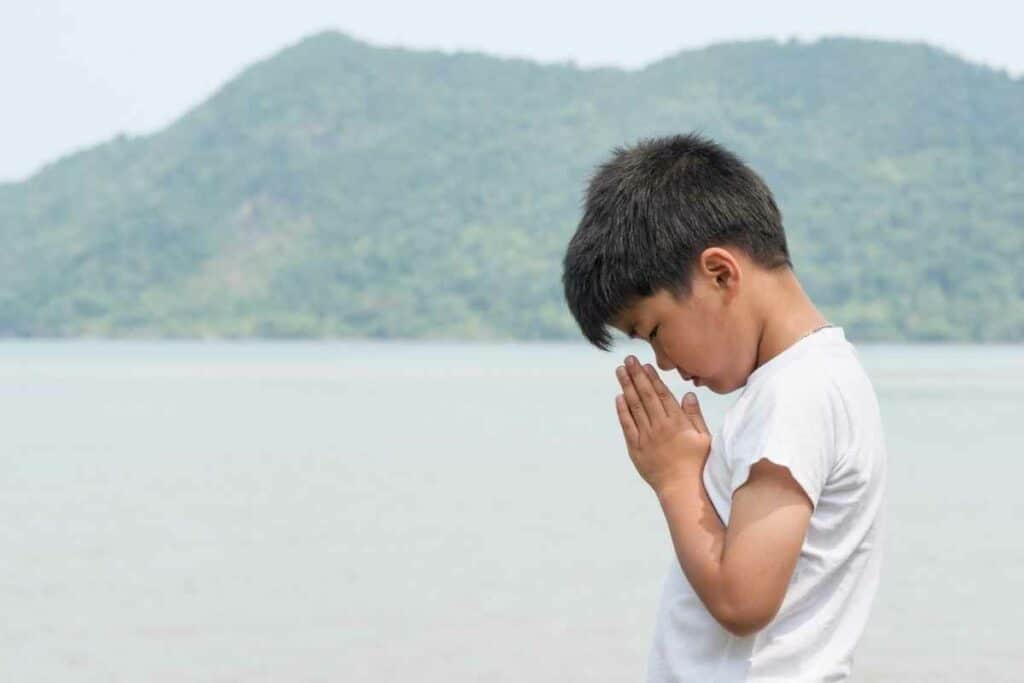
In terms of Wai’s target, you can consider this level the opposite of the first.
You perform this level to anyone older than you. This includes your older friends, schoolmates, family members, colleagues, and acquaintances. In addition, this level is for those who have respectable status — regardless of age. They could be your bosses, your teachers, and anyone you personally respect.
Level two starts like level one. Clasp your hands on your chest, then bow your head down. However, you have to bow a bit deeper this time. Keep going down until your thumbs touch the tip of your nose and your indexes touch between your eyebrows.
In case of greetings, say “Sawasdee” as you bow. However, you must add the “Krab” or “Ka” too. In Thai culture, speaking to elders or a respectable figure requires politeness. So, adding “Krab” or “Ka” is a must on this level. Or else, you will be seen as a rude brat.
Unlike level one, this level is still widely performed by the locals. As mentioned, politeness is an essential aspect of Thai culture. They cannot throw these niceties away when dealing with seniority and praise-worthy status.
Level 3: Religious figures and Buddha’s images
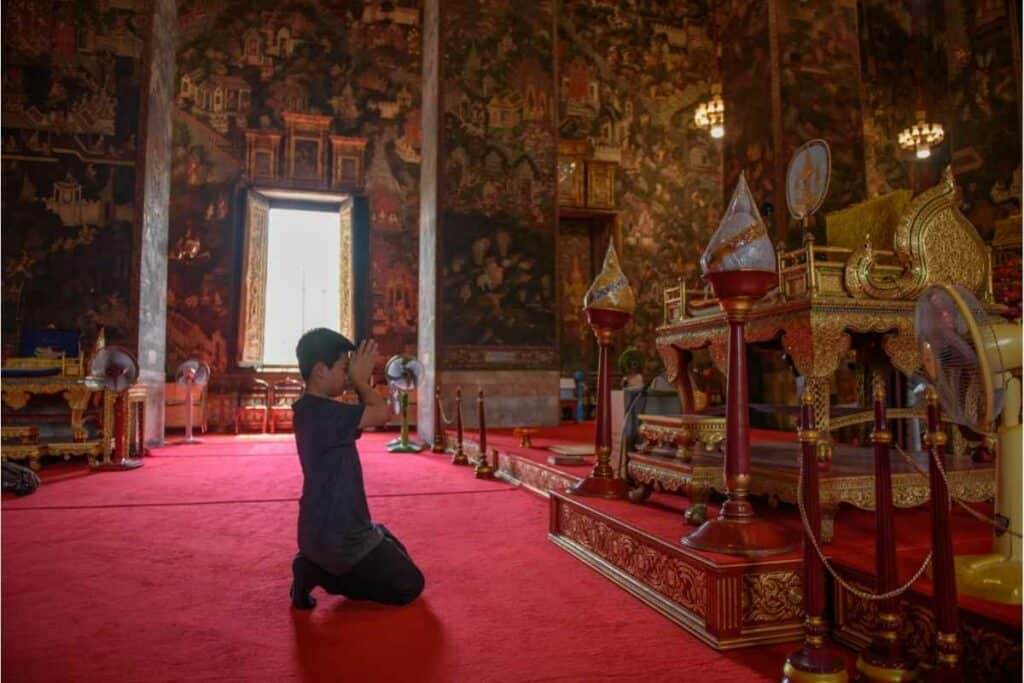
Of all Wai levels, this level displays the most respect. It also reflects the depth of the relationship between the Thai people and Buddhism.
And by the way, this level is arguably the most difficult to perform. You have to bow so deep that you could injure your neck (not that easily, but it happens).
The target of this level is simple: monks. However, the process is a bit more complicated.
Like other levels, you start by clasping your hands at your chest. Then, bow your head. Keep going down until your thumbs touch between your eyebrows and your indexes touch the top of your forehead.
Now comes the hard part: the language. In the case of greetings, instead of saying “Sawasdee,” you say “Namaskarn.” (Note the similarity with Namaste.) This is a term reserved for greeting the monks only. No matter how old the monk is, you always say “Namaskarn.”
Of course, don’t forget to add “Krub” or “Ka.” Politeness is required here.
Another tricky bit of this level is that you can use it to show quick respect for Buddha’s image. If you visit a temple or pass by one, you should perform the 3rd level Wai.
However, you don’t have to say anything when Wai-ing the Buddha’s image. Neither “Sawasdee” nor “Namaskarn.” Only the Wai suffices. After all, the Buddha won’t greet you back.
Extra level: Receiving a Wai
In Thai culture, younger people usually initiate greetings.
This means: it is rare for elders to do the level one Wai to their children first. Even if the older people see them first, they will just call the young ones out and let them initiate the greetings.
After the young perform level two Wai, the old will perform what Thai people call “Wai receiving” — the extra level of Wai culture.
Of course, there is nothing wrong with returning a Wai with a Wai of the same level. However, it is much more convenient to do the “Wai receiving.” All you need to do is clasp your hands like in step one of all other levels. And that’s it.
You still need to say “Sawasdee,” though. At its core, “Sawasdee” is like a wish in the form of a greeting. Its meaning is close to “wish you happiness.” So, you should always return a “Sawasdee” with a “Sawasdee.”
Now. Do you need to add “Krab” or “Ka” to this level? The answer is it depends. Most when you receive a Wai, it would be from someone younger than you. So, it isn’t necessary.
But of course, you can add them to be extra polite. Politeness always enhances your elegance but also creates a sense of distance. So, if you want to show intimacy, you can omit the “Krab” or “Ka.” If not, adding them will be okay.
▸ READ MORE about ▸ Thai Traditions and Thai Etiquette
3 Tips for a Beautiful Wai
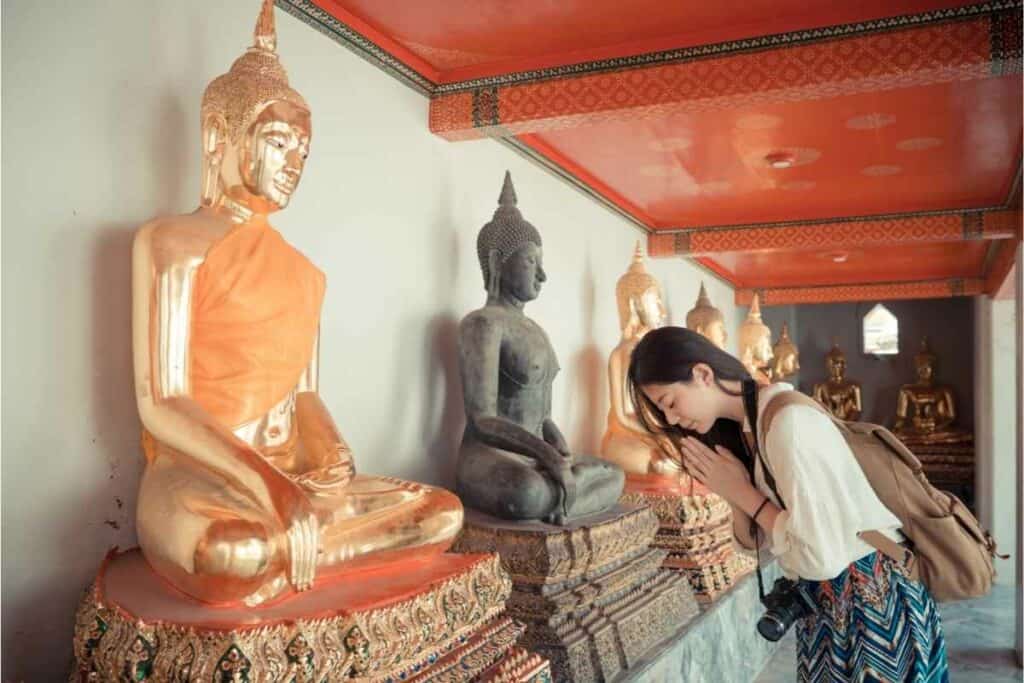
1. Avoid lifting your hands
Wai is all about humility and showing respect. So, you should do whatever it takes to bow as low as you can on each level.
And the trick to do that is, “do not lift your hands from your chest.”
This way, your Wai will also look firmer and politer. Lifting up your hand makes it easier to reach the contact points, but it ruins your bow and posture.
Of course, there is an exception on level three. Because you have to bow so deep, it might be impossible for people with stiffer or longer necks. So, lifting your hands a bit on this level is acceptable.
2. Break the eye contact
You cannot keep eye contact while you bow. If you try to keep it, your bow’s angle will be limited — resulting in a ridiculous posture.
So, it is okay to look at the floor while you Wai. You can always reconnect the eyes when you are done.
3. Smile
Thailand is a land of smiles. So, you should always smile when you perform Wai as a greeting. You could even say that smiling is the actual first step of Wai.
Keep smiling from the beginning till the end. And maybe, that smile will stick throughout the conversation.
When else do Thai people Wai?

As mentioned, Wai is more than just a greeting ritual in Thailand. You can do it in other situations too. And here are the 3 more occasions you can and should perform a Wai.
1. Saying ‘Thank You’
Besides humility and respect, Wai can also express gratitude.
When you want to say “thank you” to someone, you should perform a Wai of an appropriate level. However, change the phrase from “Sawasdee” to “Khob Khun” or “Khob Jai.” Both mean “thank you.” However, you use them in different contexts.
“Khob Khun” is used when you want to thank an older or a respectable person. Basically, you say this with level two or higher Wai. Of course, you add “Krab” or “Ka” too.
“Khob Jai” is used when you want to thank a person of the same age or younger. So, say it with level one Wai. The “Krab” or “Ka” is unnecessary here.
2. Saying ‘Goodbye’
All greetings come with farewells. In Thai culture, both instances just happen to utilize the same ritual.
You can perform a greeting Wai of the appropriate level again when you bid farewell. Clasp your hands. Bow. And say “Sawasdee.” You can almost say that this is more convenient than English.
Korea also has this culture. Their “Hello” and “Goodbye” can use the identical phrase: “annyeong.”
3. Saying ‘Sorry’
Bowing when you say sorry is a common culture across the globe. So, Thai people also perform the bow-involving Wai in their apologies.
The steps and levels are almost the same as in the greetings. You only need to change the phrase to “Khor Toad.” Of course, adding “Krab” or “Ka” is always recommended. You don’t want to appear rude when you apologize.
Thai Wai as a culture
After reading this far, you must have realized that Wai is much more than a greeting.
Of course, you can’t deny its reputation as an elegant way to say hello. But it would be better to see it as what it really is. Wai is conduct that embodies humility, gratitude, and sincerity. Its versatility and delicacy make it an essential part of Thai life.
Now you have mastered your Wai, you can learn more about Thai body language and hand gestures here.
Like always, if you want to discover more about Thailand, stay guided by ThaiGuider. You might learn something you never knew about this unique country.
▸ CHECK OUT our Complete Guide on ▸ Thai Culture
THINKING ABOUT A TRIP TO THAILAND?
I am working on a FREE Thailand Travel Guide with a FULL 7 Day Itinerary. Be the first to receive it!
Thank you for signing up.
Something went wrong.
